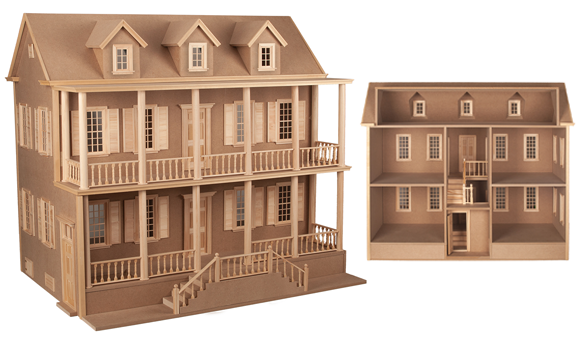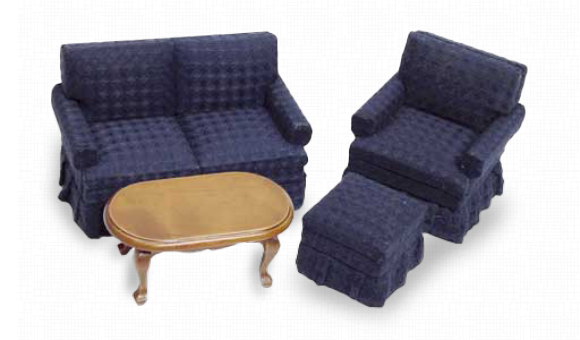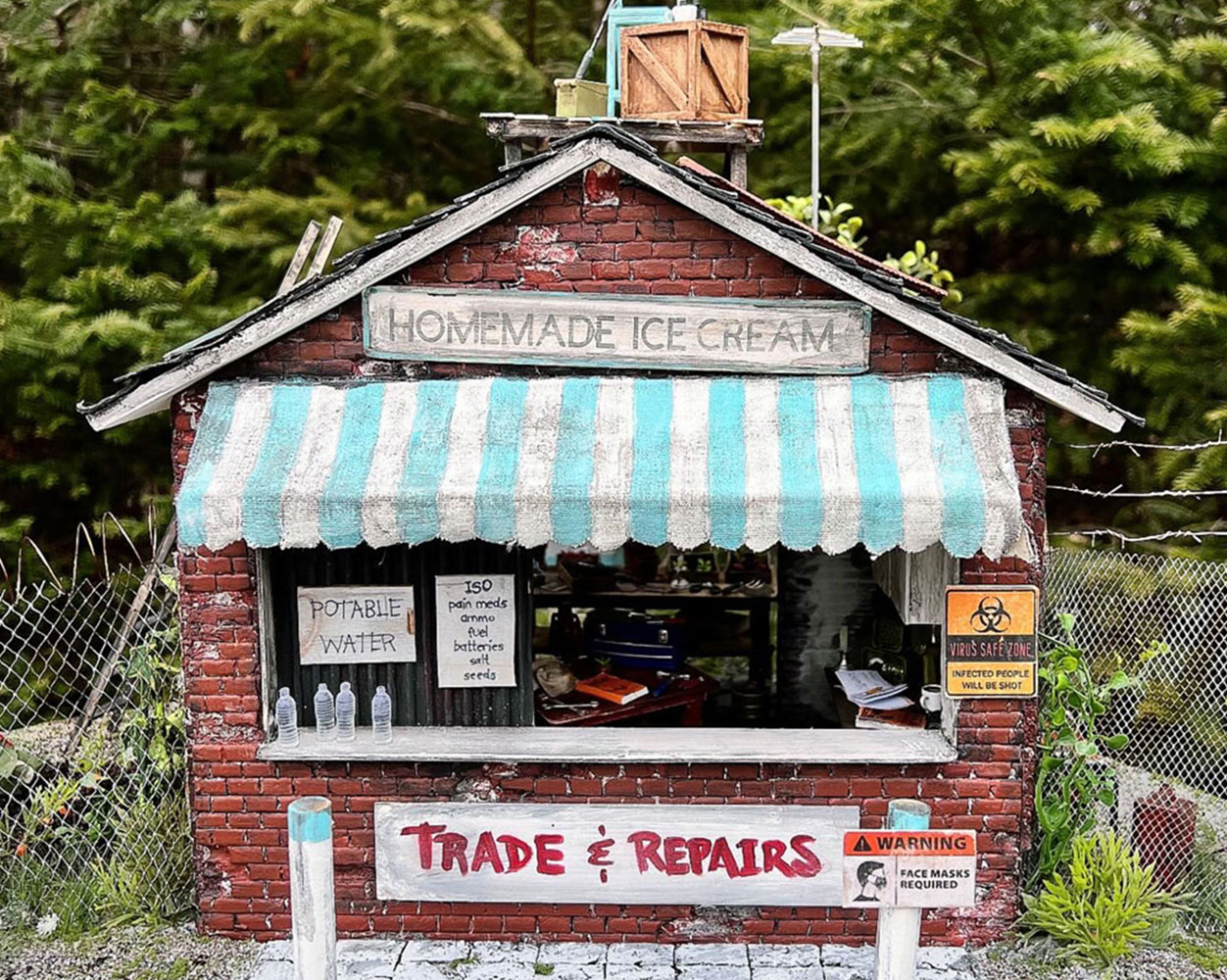
Stained Glass
To make stained glass windows for your dollhouse, you may either use the Lasertech windows or create your own. I suggest using a picture of a stained glass window as a pattern. Choose a picture of a stained glass window and place it under a plain piece of Plexiglas. There are stained glass paints available in clear and opaque finish. Decide which colors you want for your window and how to paint the design.
I use a small artist brush to apply the stained glass paint. Be careful to stay within the lines, so the paint will not run together. Let the pane dry overnight before placing it into the window or door. When placing your pane in the window or door, always put the painted side to the inside. This will protect your handiwork, especially if your window or door has an acrylic window already in place. If you are placing the painted stained glass against an acrylic window that is already in place, put the painted side against the acrylic window. This gives you a smooth surface on both sides.
To give the window a leaded look, l use the lead tape available at your local miniature shop. Carefully cut the lead tape into narrow strips about 1/16" to 1/32" wide. Run these lead tape strips along the line, and press them on firmly. You can paint the acrylic panes before or after leading. Liquid Lead can be used instead of the lead tape. Apply the liquid lead with a Monoject syringe, or a bottle with a pointed tip that has a small hole, to make a very narrow bead along the lines.
When you have a particular pattern for stained glass that you would like to use, put the clear acrylic pane from the window over the picture. Then lead along the lines and paint the sections as before. When you pick up the window pane, you will have your own stained glass window.
- Use fine nylon netting for the screen wire.
- Paint the netting with a fine coating of silver spray paint.
- Make frames to fit behind the porch post and railing from roof to floor. Make two identical frames using 1/8" x 1/16" strip wood.
- Paint the strip wood frames.
- Glue the silver netting between the two frames.
- Glue the frames into place.
- Leave a space by the steps for a screen door. You can make or purchase a screen door and attach it with hinges (Brass Butt Hinge.)
- You can also replace the porch railing with solid wood or wood panels, and use the screen frames for the upper half only.
- When using the railings, the screen frame should go from roof to floor.
1/24 Scale Church Pews
Use 1/12 scale Fishscale Shingles for the ends of the pews. Finish the pews by using strip wood cut to the length and width necessary for the seat and back.
Reducing Pictures for the Dollhouse
By following the steps outlined below, you can personalize your dollhouse with pictures from your own home and family.
- Arrange your pictures on the ground in direct sunlight (even with glass).
- With a camera, stand above the arrangement on a chair or step stool.
- Frame the arrangement in the view finder for size, and take a picture of the arrangement.
- When you have the film developed, request a matte finish.
Magazines
To make miniature magazines, I use the same process as above for reducing pictures.
- Open the magazine and lay it on the floor with the front and back cover facing up. You can usually take pictures of two or three magazines at a time. Try to get the magazines as flat as possible.
- With a camera, stand on a ladder or step stool above the magazines.
- Frame the grouping in the view finder for size and take a picture.
- When developing the film for magazines, I usually get a regular or glossy finish.
- Cut the magazines out of the picture. Fold the pieces in half, making sure the front and back are even. This process might involve a little trimming.
- Cut plain white paper a little bit smaller than the cover and fold in half. I usually use three pieces of paper, which, when folded, result in six pages.
- With the Monoject Glue Gun, run a line of glue on both the inside fold of the cover and the outside fold of the pages. Press the pages into the cover and let dry.
Making Soap Suds
Carefully melt canning paraffin in an old pan. After the paraffin melts, take an old hand egg beater and beat the wax to make soap suds.
Wet Clothes on the Clothesline
For the look of wet clothes to hang on a clothesline, dip the clothes in a liquid resin and form into the shape and position you want. Then let them dry on the line. To make water drops, drip liquid resin on wax paper and let dry. Then place the drops around water buckets, water pumps, etc.
- Cover the table with plastic wrap.
- Lay the table cloth on the table.
- Spray the table cloth with hair spray until it is wet.
- Drape the cloth to your satisfaction and let dry.
- Pin lace in folds on a piece of cardboard.
- Spray with hair spray.
- Let dry.
- Glue on window.
Piano Hinges
You can find piano hinges at your favorite hardware store. They will both cut the hinge to the length you specify and file the end. Sometimes it is more economical to buy the largest one and cut several for various projects. These hinges are better to use on front opening houses, so the doors do not sag. They are also good for the roof-opening houses.
Victorian Corner Protector
This wooden protector goes over the wallpaper, on a corner, about 2/3 of the way up the corner of the wall and butts against the top of the baseboard.
- Cut three pieces of quarter round the proper length and glue together.
- Round off the top by sanding.
- Be sure to stain the pieces before you glue them together, or paint after they are glued together.
- Glue the protector onto the corner, after you have wallpapered.
Stone Fireplace, Chimney and Foundation
For field stone foundations, chimneys or fireplaces, I collect stones from a gravel driveway, beach or yard. Most all of these stones have a flat side that can be glued onto the wood. Sometimes I paint the wood a dark grey, then fit the stones on, one by one, arranging them about 1/16" apart. This gives the appearance of a real stone foundation, because the stones are different sizes and colors. If you so desire, you can mortar or grout between the stones.
To Simulate the Stone Look
We have come across a great product that can be used for miniature projects - Fleck Stone by Plasti-kote. It comes in six colors, and in both textured and smooth finish. Fleck Stone is great for making the old fashioned cement window frames. Take the wooden window frames, and spray them with Fleck Stone. Also, to make the stone top for the brick posts, spray the wooden block with Fleck Stone. For a gravel look for driveways or paths, glue wood shavings on a piece of wood or cardboard, and spray with Fleck Stone. Try it, and I am sure you will become very creative with the items that you can make, such as mouldings, picture frames, etc.
Flower Arrangements
Miniature flower arrangements or plants are easy to make using dried, silk, plastic or Fimo flowers and greenery. The containers for these arrangements can be as varied as your imagination. Some suggestions are: clay flower pots, ceramic pots, brass bowls and vases, wooden boxes or bowls, baskets, glass containers, etc. To fill the pots:
- Fill the container with white glue, silicone adhesive, floral clay, or Styrofoam.
- When using floral clay or Styrofoam, cover the top with white glue.
- Dip the top into "dirt" or sprinkle the top with "dirt." "Dirt" may be real dirt, old coffee grounds, or tea from a used tea bag that has been dried.
- To make the arrangement, place the flowers and greenery pieces one by one into the container.
- After the arrangement meets your satisfaction, place it in a safe place to dry overnight.
Miscellaneous Construction Methods
- Combination Glue Method:
This is an excellent method to use when plywood pieces are warped. Use a good carpenters glue, along with applications of hot glue, in the same joint. - Using a Monoject Glue Gun filled with carpenters wood glue, run glue lines along the edges about 6" long leaving a 1" space between.
- Using the hot glue gun, fill in the 1" spaces.
- Quickly fit the two pieces together.
- Pull the pieces apart, and then press them together, until the hot glue takes hold.
- Tack the two pieces together with nails, spaced about 2" apart.
- While both putting the pieces together and nailing, use a piece of wood of equal height as a support, in order to hold the two pieces into place.
- Make sure each nail is going through correctly, before hitting the nail all the way through. If it is not going in correctly, there is still enough of the head exposed to be able to pull it out.
- Blind Nailing:
Sometimes you will be nailing into a part where both sides are not visible. Sight across the piece and draw a nailing line with a ruler. Drive the nails straight in, or at an angle when necessary. Check to make sure that the nails are not coming through below, before driving them in completely. This method is used to attach the roof on the porch kits. - Temporary Assembly:
To hold a piece temporarily in place, apply two small dots of hot glue. When the assembly is ready to be separated, it may be knocked apart. If the glue sticks too well, use a hair dryer to reheat for separation. - Preparing Wood Surfaces for Decorating Later:
On surfaces that will be painted, apply all nails with a nail set. The head will be driven below the surface, leaving a space. Fill the space with wood filler. Sand when dry. This method may also be used for gouges or knot holes. The smooth surface may now be painted.






